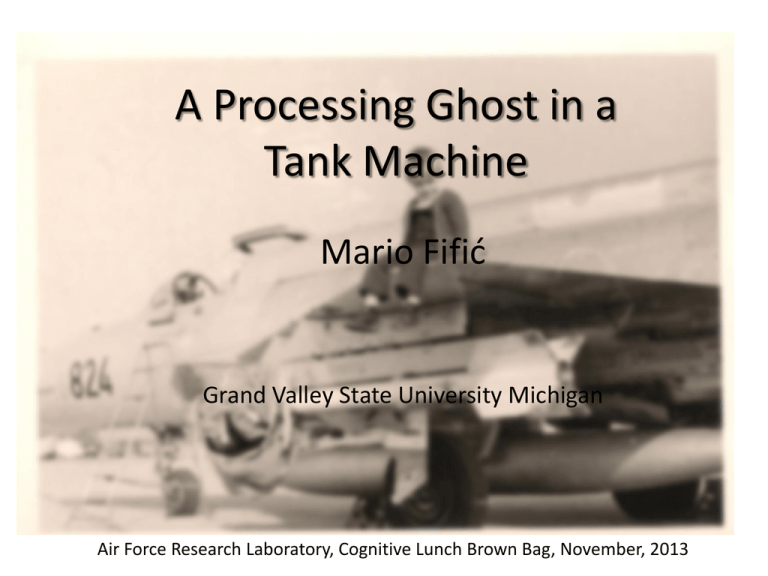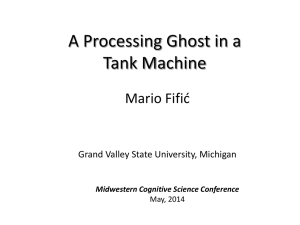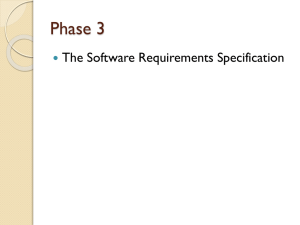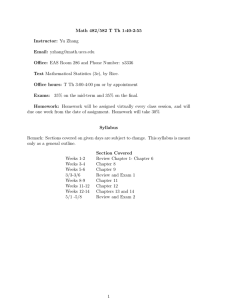A Processing Ghost in a Tank Machine Mario Fifid
advertisement

A Processing Ghost in a Tank Machine Mario Fifid Grand Valley State University Michigan Air Force Research Laboratory, Cognitive Lunch Brown Bag, November, 2013 A Processing Ghost in a Tank Machine Mario Fifid Grand Valley State University Michigan Air Force Research Laboratory, November, 2013 Research Perspectives Mario Fifid Grand Valley State University, MI • My research interests center on developing a process-tracing approach that allows for precise determination of the fundamental properties of the mental processes that underlie cognitive actions. 20:27 Theoretical advances 20:27 A magnifying glass on human cognition PERCEPT ANALYTIC 20:27 The applications 20:27 Motivation o Understanding mind’s cognitive mechanism o Understanding the brain’s neural mechanisms o Assessment of individuals with application in Clinical, Personality, Developmental Psychology 20:27 Stopping Rule Selection (SRS) Theory Applied to Deferred Decision Making Mario Fifić Grand Valley State University Marcus Buckmann NSF (SES-1156681) 20:27 Max Planck Institute for Human Development, Center for Adaptive Behavior and Cognition, Berlin 2013 Psychonomic Society Annual Meeting, Toronto A Processing Ghost in a Tank Machine Mario Fifid Grand Valley State University Michigan Air Force Research Laboratory, November, 2013 Working memory (WM) under consideration • • • • • Processing order Capacity status Subdivision by modalities Dual or one system Status of mental representations & resource allocation Resource allocation models of WM • The discrete-slot model proposes that WM operates on the ALL-OR-NONE principle: holding only highresolution item representations stored in a limited number of memory slots. – The slots+averaging model is variant of the discrete-slot model assuming that more than one slot could be allocated to a single item representation • the variable-resources model WM operates on the ALLGET-SOME principle: a pool of limited resources is dynamically allocated across a set of memorized items representations. Lim f(x) n->Infinity Why status of mental representations? • Resource allocation. • If representations are ALL-OR-NONE, and the system’s capacity is limited, then when there is information overload an operator must guess. • Sophisticated guessing? • Neural system’s implications. Resource allocation in model of WM ALL-OR-NONE Discrete slots model Slots+Averiging Equal distribution ALL-GET-SOME A continuous resource model Evidence supporting Discrete Slots Model • • • • Zhang & Luck 2008 Cowan (2001) The magical number 4 in short-term memory Rouder, Morey, Cowan, Zwilling, Morey, & Pratte (2008). Donkin, Nosofsky, Gold, & Shiffrin, (in press 2013). Evidence supporting the Variable-resource model • van den Berg, R., Shin, H., Chou, W.C., George, R., & Ma, W.J. (2012) • Bays & Husain (2008) van den Berg, et al. (2012). Appendix.. Unresolved question(s) (what’s under the all-or-none carpet) • (1) We argue that the above research advances have been downplaying the experimental approaches to directly manipulate the allocation of resources across item representations held by WM. • Our study showed that, when instructed, subjects adaptively allocated a limited amount of resources and shared them across memorized item representations. Unresolved question(s) (what’s under the carpet) • (2) The exact mechanism of resource allocation has not been specified. Specific Research Questions How are the resources allocated in WM? (HalfHalf rule) What is the status of mental representations in WM? How are the capacity resources allocated? 0.30 Memorized Items Target 0.25 0.20 0.15 0.10 0.05 0.00 1 2 3 4 5 Item Serial Position 6 7 0.30 Ascending Descending Memorized Items Target 0.25 0.20 0.15 0.10 0.05 0.00 1 2 3 4 5 Item Serial Position 6 7 Propotion of Allocated Capacity Equal Propotion of Allocated Capacity Propotion of Allocated Capacity Attentional gating function in STM 0.30 Memorized Items Target 0.25 0.20 0.15 0.10 0.05 0.00 1 2 3 4 5 Item Serial Position 6 7 How are the capacity resources distributed? The Half-Half Optimal Rule • The optimal solution for allocation of a limited amount of resources: one Half of resources should be allocated to memorized items and another Half to a target. N -1 arg max[ Target Itemi ] Target i N -1 Target Item i N -1 Target Itemi Target (TotalCapacity - Target) i i Target TotalCapacity - Target 2 d [Target TotalCapacity - Target 2 ] TotalCapacity - 2 Target dTarget TotalCapacity - 2 Target 0 Target 1 TotalCapacity 2 The Target Locking Hypothesis Propotion of Allocated Capacity • Implication for non-optimal strategies, after the Half-Half rule→ Attentional gating should aim to allocate more capacity resources to the target than to memorized items. Ascending 0.30 Memorized Items Target 0.25 0.20 0.15 0.10 0.05 0.00 1 2 3 4 5 Item Serial Position 6 7 The model The Exemplar-Based STM Retrieval Model EBRW and the ItemTarget Product Rule Capacity Distributed via Attentional Gating N number of items stored in STM Target 2 (Intercept N - TotalCap) Item Capacity(Target Capacity) f ( N) N (1 N) Assuming limited capacity f ( N , Intercept ) TotalCap N 1 EBRW r r K dij wk xik - x jk , k 1 Distance dij fixed value distance (free paramter) dij 0 , on positive match Activation* sij exp c dij Item Capacityi Target Capacity j Similarity Stepping Probability pi si,old s i ,old Capacity via Attentional Gating OLD Random Walk RTx1 NEW Time e.g. Nosofsky, Little ,Donkin, & Fific, 2011 New Method The attention-to-position paradigm • Rapid short-term memory paradigm • Focal set : To pay special attention to certain item positions in the memorized list, called a “focal set”. This means that if a target item was a member of a focal set, a response decision had to be extremely fast, and accurate • Peripheral set: The rest items not contained in a focal set. Focal set Peripheral set “First Three” “Last Three” Serial Position (1-6) “All Fast” TARGET (N=6) 5 4 9 1 2 8 5 Ti me RT (ms) & Accuracy New Method The attention-to-position paradigm • To prevent interference of extraneous variables with the process of resource allocation the subjects were instructed to pronounce each item in a set, without accentuation, and with a monotonic prosody • Two measures: mean response time (RT) and accuracy. The data Serial Position (1-6) TARGET “All Fast” (N=6) 5 4 9 1 2 8 RT (ms) & Accuracy 5 Time 1.2 580 1.0 560 0.8 P(Correct) Mean RT (ms) 600 540 520 500 0.6 0.4 OLD NEW OLD NEW Old Predicted New Predicted 480 Old Predicted New Predicted 0.2 0.0 460 0 1 2 3 4 5 Serial Position 6 Lure 0 1 2 3 4 5 6 Lure Serial Position • This is a typical RT pattern observed in the STM research, the primacy and recency (1) Equal-precision (2) ALL-OR-NONE (3) The decay-representation WM model (4) Fluid-resource model (5) Slots+averaging model The data “First Three” 1.2 600 OLD 580 Old Predicted New Predicted 1.0 NEW P(Correct) Mean RT (ms) 620 560 540 520 500 0.8 0.6 0.4 OLD NEW 0.2 Old Predicted New Predicted 480 0.0 460 0 1 2 3 4 5 Serial Position 6 Lure 0 1 2 3 4 5 6 Lure Serial Position • This is a typical pattern observed in the STM research, the primacy and recency (1) Equal-precision (2) ALL-OR-NONE (3) Decay-representation WM model (4) Fluid-resource model (5) Slots+averaging model Comparison 620 600 580 RT(ms) 560 540 520 500 480 All Fast First Three - 460 1 • Implications 2 3 4 5 6 Lure Serial Position of a target item – A discontinuous serial position effect -> Dual WM systems – The principle of resource conservation-> Strictly fixed capacity The data – further validation of resource allocation “Last Three” 600 1.2 1.0 560 P(Correct) Mean RT (ms) 580 540 520 500 OLD NEW Old Predicted New Predicted 480 1 2 0.6 0.4 OLD NEW Old Predicted New Predicted 0.2 460 0 0.8 3 4 5 Serial Position 6 Lure 0.0 0 1 2 3 4 5 Serial Position 6 Lure Comparison 620 600 580 RT(ms) 560 540 520 500 480 All Fast First Three Last Trhee 460 1 2 3 4 5 6 Serial Position of a target item Lure 1 2 3 4 5 6 78 Equal Descending 0.30 Memorized Items Target 0.25 0.20 0.15 0.10 0.05 0.00 1 2 3 4 5 Item Serial Position 6 7 0.30 Memorized Items Target 0.25 0.20 0.15 0.10 0.05 0.00 1 2 3 4 5 Item Serial Position 6 7 1 2 3 4 5 6 78 Propotion of Allocated Capacity 1 2 3 4 5 6 78 Propotion of Allocated Capacity Propotion of Allocated Capacity The proposed resource allocation model :The Tilted Water Tank Ascending 0.30 Memorized Items Target 0.25 0.20 0.15 0.10 0.05 0.00 1 2 3 4 5 Item Serial Position 6 7 Model fitting: the linear distribution function of resource allocation Estimated Capacity Allocations 600 Mean RT (ms) 0.18 All Fast First Three Last Trhee 560 540 520 500 OLD NEW 480 Old Predicted New Predicted 460 0 1 2 3 4 5 6 Lure 6 Lure 6 Lure Serial Position 0.16 600 Mean RT (ms) 580 0.14 560 540 520 500 OLD NEW Old Predicted New Predicted 480 460 0.12 0 1 2 3 4 5 Serial Position 620 0.10 1 2 3 4 5 6 Item's Position in the Set 7 Mean RT (ms) Capacity Proportion Allocated 580 600 OLD 580 Old Predicted New Predicted NEW 560 540 520 500 480 460 0 1 2 3 4 5 Serial Position discrete-slot model slots+averaging model × Lim f(x) n->Infinity ? variable-resources model How many boxes? • Conduct data fitting of the EBRW model that can freely allocate fixed amount of resources across memorized items, including the parameter which defines a number of possible memory slots (boxes). • In other words: find the number of possible resource allocation units (slots, boxes) that maximizes the goodness of fit of the model for resource allocation. How many boxes? Params Free resource parameter-EBRW mode First All Fast Three Last Three c acrit bcrit scale mu listbase dscale m1 m2 m3 m4 m5 m6 0.959 2.52 3.936 44.706 175.816 0.175 2.705 0.145 0.131 0.132 0.161 0.201 0.231 1.6 11.378 17.164 1.901 256.035 0.42 0.65 0.128 0.131 0.128 0.176 0.208 0.229 boxes 801 𝑚𝑖 = 1 2.383 3.556 43.592 4.576 137.859 0.261 0.979 0.161 0.166 0.167 0.170 0.172 0.164 670 𝑚𝑖 = 1 711 𝑚𝑖 = 1 Conclusions New method for testing WM, attention by instruction Support for the variable-resources model WM, all-get-some Falsification of all-or-none approaches, discrete representations We specified a likely mechanism of resource allocation (Target locking) and provided rationale The ghost is likely to reside in a tilted tank! Further Implications: Linear distribution function of resources could serve as a proxy to the Attentional Gating mechanism. Falsification of Dual system WM view: the last item position advantage A joint fit of mean RT and choice probabilities.[EBRW] A STM capacity resources are strictly limited (the conservation of resources principle) fificm@gvsu.edu research: http://faculty.gvsu.edu/fificm/index.html Free allocation of fixed capacity model Resource Distribution Function 2D Graph 1 0.22 0.20 0.18 0.16 0.14 All Fast First Three Last Trhee 0.12 0.10 1 2 3 4 5 6 Serial Position of a target item







